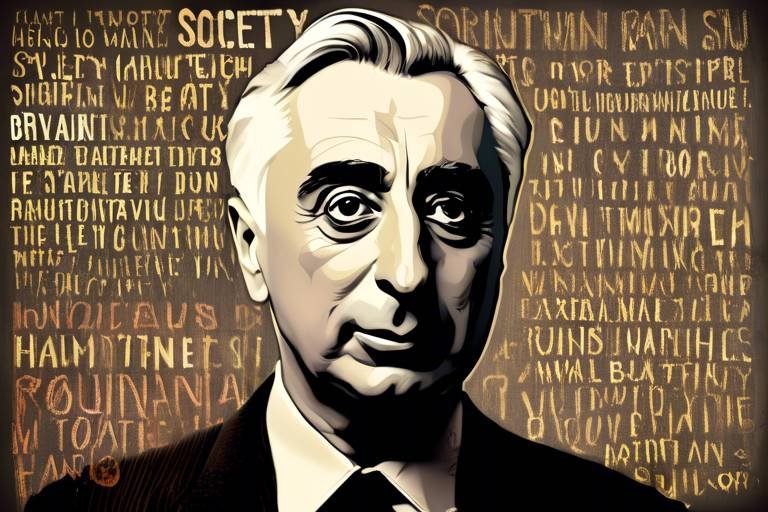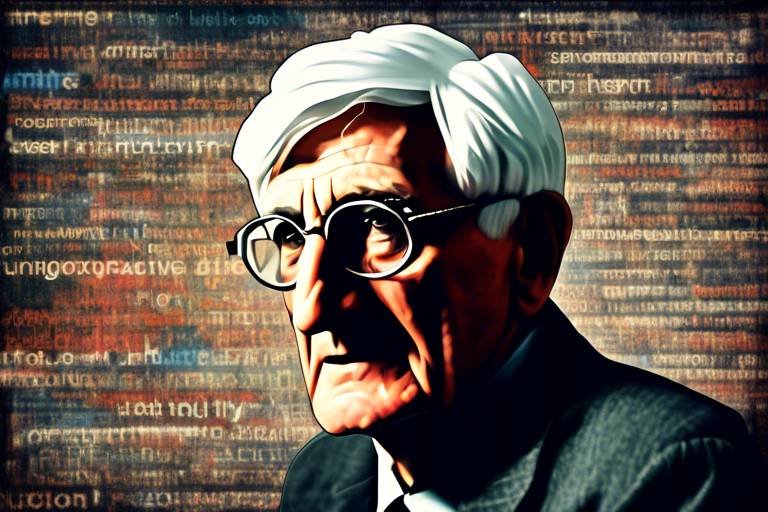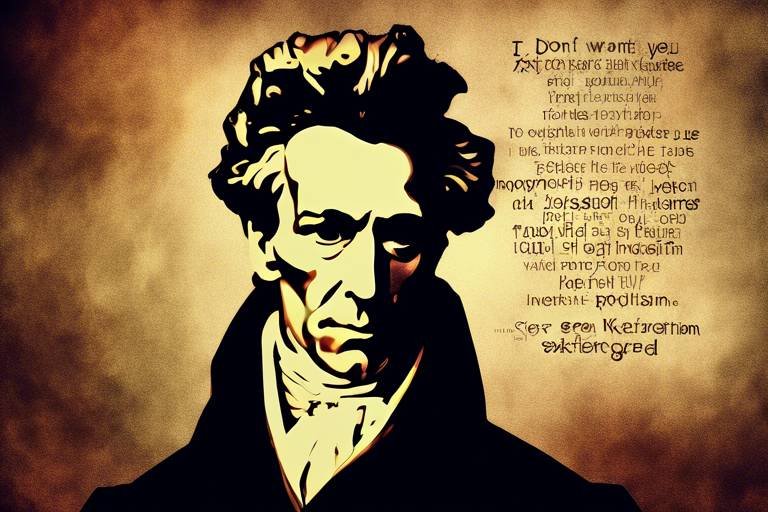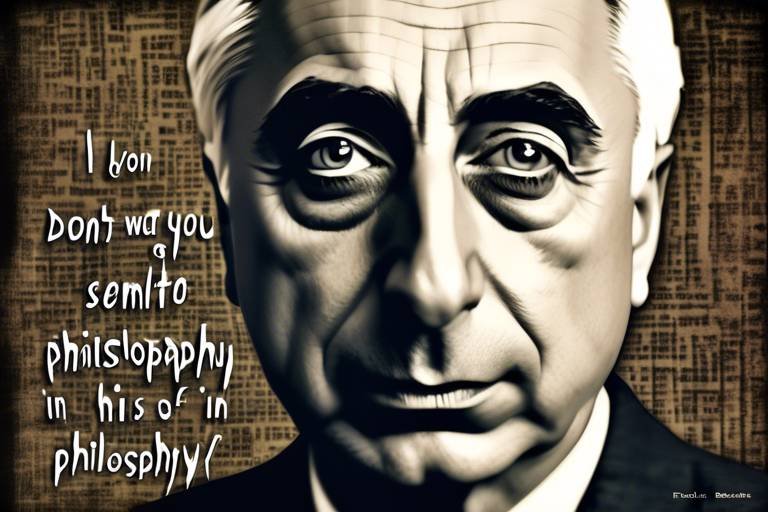Roland Barthes on Myths in Modern Society
In an age where information is at our fingertips and narratives shape our understanding of reality, Roland Barthes' theories on myths resonate more than ever. Barthes, a French literary theorist, philosopher, and semiotician, delved deep into the fabric of culture, revealing how myths are not just ancient tales but powerful constructs that influence our perceptions and beliefs today. His insights invite us to question the narratives we encounter daily, from advertisements to news stories, and to recognize the underlying meanings that shape our collective consciousness.
Barthes defines myth as a form of communication that conveys cultural meanings, serving as a bridge between the world of signs and the cultural narratives we live by. In his view, myths are not merely stories; they are social constructs that reflect and shape our understanding of reality. By examining myths, we can uncover the ideologies that underpin our society, often operating beneath the surface of our daily lives. This exploration of myth allows us to see how our perceptions are influenced by the cultural context in which we exist, making Barthes' theories essential for understanding the complexities of modern societal narratives.
Language is the backbone of myth-making, and Barthes emphasizes its crucial role in shaping cultural narratives. He argues that the structures of language not only convey information but also create and perpetuate myths that influence how we perceive the world. In this way, language acts as a powerful tool that can either reinforce or challenge societal norms. The intricate relationship between language and myth raises questions about the nature of communication and the ways in which we construct meaning in our lives.
One of Barthes' key contributions to the study of myths is his distinction between denotation and connotation. Denotation refers to the literal meaning of a word or image, while connotation encompasses the cultural and emotional associations that come with it. This layered approach to language illustrates how myths are constructed and understood. For instance, when we see an image of a rose, the denotation is simply "a flower," but the connotations could include love, beauty, and romance. This duality enriches our understanding of myths and highlights how they can convey complex societal implications.
To illustrate the concept of denotation, consider the following examples:
| Image/Text | Denotation |
|---|---|
| Picture of a Dove | A bird often associated with peace. |
| Image of a Flag | A piece of fabric representing a nation. |
These examples show how the surface meanings are established, laying the groundwork for deeper interpretations.
Now, let's take a look at how connotation enriches our understanding of myths:
| Image/Text | Connotation |
|---|---|
| Picture of a Dove | Symbol of peace, hope, and freedom. |
| Image of a Flag | Patriotism, unity, or division, depending on context. |
These connotations add layers of cultural significance that shape societal beliefs and values, illustrating the profound impact of myths on our everyday lives.
According to Barthes, myths serve essential social functions. They reinforce ideologies, create collective identities, and maintain social order. By examining the myths that pervade our culture, we can better understand the values and beliefs that are upheld within society. Myths act as a mirror, reflecting our aspirations, fears, and desires, while simultaneously shaping our perceptions of reality. This interplay between myth and society highlights the importance of critically analyzing the narratives we encounter, as they often hold the power to influence our actions and beliefs.
Barthes' theories can be applied to analyze myths in popular culture, revealing how advertising, media, and entertainment perpetuate specific narratives that reflect societal values and aspirations. In a world saturated with images and messages, understanding the myths embedded in popular culture is crucial for navigating our contemporary landscape.
Advertising often constructs myths to sell products, creating narratives that resonate with consumers. Brands tap into cultural symbols and values, crafting stories that evoke emotions and desires. For example, a luxury car commercial may not just sell a vehicle but an entire lifestyle of success, freedom, and prestige. By analyzing these advertisements, we can uncover the myths that shape consumer behavior and societal expectations.
The media plays a pivotal role in shaping cultural myths. News, films, and television contribute to the construction and dissemination of societal narratives, influencing how we perceive various issues and identities. Whether it's the portrayal of certain groups or the framing of events, media representation can reinforce stereotypes or challenge existing beliefs. Understanding these narratives is essential for fostering critical thinking and promoting a more nuanced view of the world.
- What is Roland Barthes known for?
Barthes is known for his contributions to literary theory, semiotics, and cultural criticism, particularly his analysis of myths in modern society. - How do myths influence our perceptions?
Myths shape our beliefs and values, often operating beneath the surface of our daily lives, influencing how we interpret various cultural narratives. - What is the difference between denotation and connotation?
Denotation refers to the literal meaning of a word or image, while connotation encompasses the cultural and emotional associations that come with it.

The Concept of Myth
Roland Barthes, a luminary in the field of semiotics, presents a fascinating exploration of the concept of myth as a complex form of communication that encapsulates and conveys cultural meanings. At its core, Barthes argues that myth is not just a collection of stories or traditional narratives; rather, it is a social construct that shapes our perceptions and beliefs about the world around us. Think of myth as a lens through which we view reality—one that can either clarify or distort our understanding depending on the narratives we choose to embrace.
In Barthes’ view, myths are deeply embedded in the fabric of modern society, influencing everything from our daily interactions to our broader cultural norms. They serve as a bridge between the individual and the collective, allowing us to navigate complex social landscapes. By understanding myths, we can better comprehend how they reflect and shape our identities, values, and worldviews. For instance, consider the myth of the "American Dream." This narrative suggests that anyone, regardless of their background, can achieve success through hard work and determination. While this idea can be empowering, it also glosses over the systemic barriers that many face, thereby perpetuating a simplified view of reality.
Moreover, myths are not static; they evolve over time, adapting to cultural shifts and societal changes. Barthes emphasizes that myths are created through a process of mythologization, where cultural meanings are constructed and reinforced through language and imagery. This dynamic nature of myth allows it to resonate with different audiences, making it a powerful tool for communication. For example, myths surrounding gender roles have transformed significantly over the decades, reflecting changes in societal attitudes towards gender equality.
To illustrate Barthes' concept of myth further, we can break it down into key components:
- Myth as Communication: Myths convey messages that go beyond their literal meanings, embedding deeper cultural significance.
- Myth as Social Construct: Myths are shaped by societal norms and values, influencing how we perceive ourselves and others.
- Myth as Evolving Narrative: Myths adapt to cultural changes, reflecting the ongoing dialogue between tradition and modernity.
In conclusion, Barthes’ interpretation of myth offers a profound insight into how cultural narratives influence our understanding of the world. By recognizing myths as powerful communicative tools, we can critically engage with the stories we tell and the beliefs we hold, ultimately empowering ourselves to challenge and reshape the narratives that define our lives.

Myth and Language
Language is not just a tool for communication; it is a powerful vehicle that shapes our understanding of the world. Roland Barthes posits that myths are constructed through language, and this relationship is vital for grasping how cultural narratives are formed. When we engage with language, we are not merely exchanging words; we are participating in a complex web of meanings that influence our perceptions, beliefs, and, ultimately, our actions. Barthes argues that myths arise from the interplay of linguistic structures, where words and images combine to create a shared understanding of reality.
To illustrate this, consider how specific words carry different meanings depending on their context. For instance, the word "freedom" might evoke thoughts of liberation and independence in one context, while in another, it could suggest chaos and lack of control. This duality is crucial in understanding how myths are constructed. Barthes emphasizes that the way we use language can either reinforce existing myths or challenge them, making it a crucial battleground for cultural discourse.
Moreover, Barthes introduces the concepts of denotation and connotation, which are essential in the analysis of myths. Denotation refers to the literal meaning of a word, the straightforward definition that everyone can agree upon. In contrast, connotation encompasses the emotional and cultural associations that a word carries beyond its dictionary definition. This distinction is vital because it highlights how myths can be built upon both the explicit meanings and the underlying implications of language.
When we look at a cultural artifact—be it a text, an image, or an advertisement—we often encounter layers of meaning. For example, the image of a dove might denote peace, but its connotations can vary widely, suggesting purity, hope, or even fragility. This interplay of denotation and connotation allows myths to flourish, as they draw upon a shared language that resonates with collective experiences. Barthes suggests that the richness of these meanings contributes to the construction of myths that reflect societal values.
Let’s take a closer look at specific examples. Consider the iconic image of the American flag. At first glance, it simply denotes a national symbol. However, beneath this surface meaning lies a myriad of connotations, such as patriotism, freedom, or even oppression, depending on one’s perspective. This duality is what makes myths so compelling; they are not static but dynamic, evolving as society changes.
On the other hand, when we analyze connotations, we see how they enrich our understanding of myths. For instance, a luxury car advertisement might denote a vehicle but connotatively suggests wealth, status, and success. These associations are not merely coincidental; they are carefully crafted narratives that brands use to connect with consumers on an emotional level. By tapping into these connotations, advertisers create myths that resonate with societal aspirations and desires.
In conclusion, the relationship between myth and language is intricate and profound. Barthes’ theories illuminate how our use of language shapes the myths we encounter daily. By understanding the dynamics of denotation and connotation, we can begin to unravel the narratives that influence our beliefs and behaviors. Language, in this sense, is not just a means of communication; it is a powerful force that molds our cultural landscape.
- What is the difference between denotation and connotation? Denotation refers to the literal meaning of a word, while connotation involves the emotional and cultural associations tied to that word.
- How do myths influence our daily lives? Myths shape our perceptions and beliefs, influencing how we interpret cultural narratives and engage with society.
- Can language change the meaning of a myth? Yes, language can evolve and adapt, which can alter the meanings of myths and how they are understood within a culture.

Denotation and Connotation
In the realm of language, denotation and connotation are two fundamental concepts that play a crucial role in how we interpret messages and construct meaning. Barthes emphasizes that denotation refers to the literal, dictionary definition of a word or image, while connotation encompasses the emotional, cultural, and associative meanings that arise from it. To illustrate, think of the word "home." Its denotation is simply a place where one lives, but the connotations can evoke feelings of warmth, safety, nostalgia, or even a sense of belonging. This duality is where Barthes sees the power of myths taking shape, as they manipulate these layers of meaning to influence our perceptions and beliefs.
When we analyze texts or images, we must consider both denotation and connotation to fully grasp the underlying messages being communicated. For instance, in advertising, a simple image of a car might denote a mode of transportation. However, its connotations could include freedom, adventure, or status—ideas that are deeply embedded in societal narratives. This interplay creates a rich tapestry of meaning that can sway public opinion and shape cultural norms. Barthes argues that myths are constructed from these layers, as they draw on shared cultural experiences and values to resonate with audiences.
To further understand this concept, let’s break down the differences between denotation and connotation in a table format:
| Aspect | Denotation | Connotation |
|---|---|---|
| Definition | Literal meaning | Emotional and cultural associations |
| Example | The word "rose" refers to a type of flower. | Roses symbolize love, romance, or beauty. |
| Impact | Clear and straightforward | Subjective and influenced by personal experiences |
Recognizing the distinction between denotation and connotation allows us to see how myths are not merely stories but rather complex narratives that shape our understanding of the world. Myths often rely on connotative meanings to create emotional connections, reinforcing societal values and ideologies. When we consume media, whether it’s through literature, film, or advertising, we are constantly navigating this landscape of meanings. The ability to discern these layers can empower us as consumers and critical thinkers, enabling us to challenge the narratives that are presented to us.
In conclusion, Barthes' exploration of denotation and connotation reveals the intricate ways in which language and culture intertwine to create myths that influence our everyday lives. Understanding these concepts not only enriches our grasp of communication but also equips us to critically engage with the myriad of messages that surround us in modern society.
- What is the difference between denotation and connotation?
Denotation is the literal meaning of a word, while connotation refers to the emotional and cultural associations that a word carries. - How do myths influence society?
Myths shape collective beliefs and values, reinforcing ideologies and creating shared identities within a culture. - Can you provide an example of a myth in popular culture?
An example would be the myth of the "American Dream," which connotes ideas of success, freedom, and opportunity, influencing how people perceive their aspirations and societal roles.

Examples of Denotation
When we talk about denotation, we are referring to the literal, surface-level meaning of a word or image. It's like looking at a painting and simply describing what you see without diving into the emotions it evokes or the stories it tells. For instance, consider the image of a red rose. On the surface, it denotes a flower that is red in color, has petals, and a stem. But this straightforward description is just the tip of the iceberg. It’s essential to understand how such denotative meanings lay the groundwork for deeper interpretations and cultural narratives.
Let’s take a closer look at a few examples to illustrate this concept:
- Traffic Signs: A stop sign is a classic example of denotation. It is a red octagon with the word "STOP" written in white letters. The denotative meaning is clear: it instructs drivers to halt their vehicles. However, it also carries connotations of safety, lawfulness, and order on the roads.
- Brand Logos: Consider the apple logo of a well-known tech company. At first glance, it simply denotes an apple shape. Yet, it represents innovation, creativity, and sleek design in the tech world, which are deeper meanings that arise from cultural context.
- Fashion Choices: A black suit denotes formal attire. It suggests professionalism and seriousness. However, the connotations attached to it can vary widely depending on the context—ranging from power and authority to conformity and tradition.
These examples show how denotations serve as the foundation for understanding more complex societal narratives. They help us navigate the world around us, providing a common ground from which we can start to explore the more intricate layers of meaning that exist beneath the surface. For instance, when we see an advertisement featuring a family enjoying a meal together, the denotation is simply a family at a dinner table. But what does this image really communicate? It can evoke feelings of warmth, togetherness, and the ideal of family life, which are much richer connotations that influence societal values.
In essence, denotation is a vital first step in the process of meaning-making. It allows us to identify and categorize elements of our environment before we dive into the deeper, often more subjective interpretations that connotation brings. Understanding this distinction is crucial for dissecting the myths that permeate our modern society, as these myths often hinge on the interplay between what is immediately visible and what lies beneath.

Examples of Connotation
When we dive into the world of connotation, we begin to see how language is not just a simple tool for communication; it's a vibrant tapestry woven with cultural significance. Connotation adds layers of meaning that go beyond the literal definitions of words, enriching our understanding of myths and societal narratives. For instance, consider the word "home." While its denotation is simply a place where one lives, its connotations evoke feelings of warmth, safety, and belonging. This emotional resonance is what makes "home" a powerful symbol in various myths and stories.
Another example can be found in the imagery associated with the color red. In different contexts, red can symbolize a variety of concepts:
- Passion - Often linked to love and desire, red can evoke strong emotional responses.
- Danger - Think of warning signs or emergency lights; red alerts us to potential threats.
- Power - Many political and social movements use red to signify strength and authority.
These connotations shape how we perceive not just the color itself but also the myths and narratives surrounding it. For example, in popular culture, a red sports car may be seen as a symbol of freedom and rebellion, while a red rose is often associated with romantic love. Both interpretations stem from the rich connotations attached to the color red, demonstrating how cultural contexts influence our understanding of symbols.
Barthes' exploration of connotation helps us unpack the complexities of communication. He argues that myths are not merely stories but are constructed through layers of meaning that inform our beliefs and values. For instance, consider the myth of the American Dream. On the surface, it denotes the idea that anyone can achieve success through hard work. However, its connotations are much more profound; it embodies notions of freedom, opportunity, and sometimes, disillusionment. This duality creates a narrative that influences societal aspirations and individual motivations.
Moreover, connotation can also play a significant role in advertising and media. Take the slogan "Just Do It" from Nike. While the phrase's denotation is straightforward—encouraging action—its connotation is rich with implications of empowerment, determination, and grit. This resonates deeply with consumers, creating a myth around the brand that transcends the product itself. It tells a story of overcoming obstacles, pushing boundaries, and achieving greatness, which is incredibly appealing in our fast-paced, achievement-oriented society.
By understanding these examples of connotation, we can better appreciate how myths are constructed and perpetuated in our culture. They are not just tales we tell; they are the very fabric of our social existence, influencing everything from our personal identities to our collective beliefs. This exploration of connotation reveals the depth of meaning embedded in our language and the powerful role it plays in shaping our understanding of the world around us.

Myth as a Social Function
Roland Barthes presents the idea that myths are not just fanciful tales or ancient stories; they serve essential social functions that are deeply embedded in the fabric of our modern society. Myths, as Barthes suggests, act as a mirror reflecting the values, beliefs, and ideologies of a culture. They help to shape our collective identity, providing a framework through which individuals can understand their place in the world. Just like a well-crafted story that draws you in, myths have the power to resonate with our emotions and experiences, often without us even realizing it.
One of the primary functions of myth is to reinforce existing ideologies. By presenting certain narratives as 'natural' or 'normal,' myths can subtly dictate what is considered acceptable behavior or thought within a society. For instance, the myth of the "American Dream" perpetuates the belief that anyone can achieve success through hard work and determination. This narrative not only inspires individuals but also serves to justify social inequalities by placing the onus of success solely on the individual rather than acknowledging systemic barriers.
Moreover, myths play a crucial role in creating collective identities. They bind people together through shared stories and symbols, fostering a sense of belonging. Think of national myths, such as those surrounding independence or cultural heritage, which can unite people across diverse backgrounds under a common narrative. These myths provide a sense of purpose and continuity, allowing individuals to connect their personal stories with larger societal narratives. In this way, myths become a social glue, holding communities together by establishing a shared understanding of their history and values.
Additionally, myths maintain social order by providing frameworks for behavior and expectations. When individuals internalize these myths, they are more likely to conform to societal norms, as these narratives often dictate what is deemed appropriate or inappropriate. For instance, myths surrounding gender roles can influence how individuals perceive their responsibilities and aspirations. A society that upholds traditional gender myths may propagate the idea that men should be the primary breadwinners while women should focus on homemaking, thereby influencing personal choices and societal structures.
In summary, Barthes' exploration of myths as social functions reveals their profound impact on our lives. They shape our beliefs, reinforce ideologies, create collective identities, and maintain social order. Understanding these functions can empower us to critically examine the myths we encounter daily, whether in media, advertising, or even our personal lives. By doing so, we can become more aware of the narratives that shape our perceptions and challenge those that may not serve our collective well-being.
- What is the main idea behind Barthes' concept of myth?
Barthes argues that myths are social constructs that communicate cultural meanings and reinforce ideologies within society. - How do myths influence our identities?
Myths create a shared narrative that connects individuals to a larger community, fostering a sense of belonging and collective identity. - Can myths change over time?
Yes, myths can evolve as societal values and beliefs shift, reflecting changes in culture and ideology. - What role does advertising play in shaping myths?
Advertising often constructs myths to resonate with consumers, influencing their desires and perceptions of reality.

Myth in Popular Culture
When we think about myths in popular culture, it’s like peeling back the layers of an onion. Each layer reveals a new story, a new belief, and sometimes a new truth. Roland Barthes' theories offer a fascinating lens through which we can examine how myths shape our understanding of the world around us. In today’s society, myths are not just ancient tales but are alive and thriving in the realms of advertising, media, and entertainment. They influence our perceptions, drive our desires, and often dictate our social norms.
Take a moment to consider the advertisements we encounter daily. Each ad is a carefully crafted narrative designed to evoke emotions and desires. Brands don’t just sell products; they sell dreams and lifestyles, creating a mythos around their offerings. For instance, think about how luxury car commercials often portray a life of success and sophistication. The sleek lines of the car, the stunning landscapes, and the attractive individuals in the ads all contribute to a myth that owning such a vehicle equates to achieving a certain status. This is no accident; it's a deliberate construction of meaning that resonates with consumer aspirations.
Moreover, the media plays a pivotal role in perpetuating these myths. News outlets, films, and television shows often reflect and shape societal narratives, reinforcing what we believe to be true about ourselves and others. For example, the portrayal of heroes and villains in movies can create stereotypes that influence public perception. When we see a particular group consistently depicted as the antagonist, it can lead to a collective belief that aligns with that narrative. This is where Barthes' idea of myth as a social function comes into play, as these representations help maintain social order by reinforcing existing ideologies.
To illustrate this further, consider the following table that showcases how different forms of popular culture perpetuate myths:
| Medium | Myth Created | Impact on Society |
|---|---|---|
| Advertising | Success through materialism | Encourages consumerism and the belief that happiness is linked to possessions |
| Film | Heroism and valor | Shapes ideals of bravery and moral righteousness |
| Television | Family dynamics | Influences perceptions of gender roles and family structures |
In this way, myths serve as a mirror reflecting our collective values and aspirations. They not only entertain us but also shape our identities and the way we interact with the world. As Barthes suggests, understanding these myths allows us to see the underlying messages that influence our beliefs and behaviors. So next time you watch a commercial or a movie, ask yourself: what myth is being communicated here? What cultural narrative is being reinforced? By questioning these narratives, we can begin to unravel the complex web of meanings that define our modern society.
- What is a myth in popular culture?
A myth in popular culture refers to a widely held but false belief or idea that shapes societal norms and values, often perpetuated through media and advertising. - How do myths influence consumer behavior?
Myths influence consumer behavior by creating narratives that resonate with individuals' desires and aspirations, often leading them to associate products with certain lifestyles or statuses. - Can myths change over time?
Yes, myths can evolve as societal values and beliefs shift, reflecting changing attitudes and new cultural narratives.

Advertising as Myth
Advertising is not just about selling products; it's about crafting myths that resonate deeply with our desires and aspirations. In the world of marketing, brands create narratives that go beyond the mere functionality of their products. They tap into our emotions, weaving stories that transform ordinary items into symbols of status, happiness, and identity. Think about it: when you see a commercial for a luxury car, it’s not just about the vehicle itself; it’s about the lifestyle it promises, the freedom it suggests, and the success it symbolizes. This is where Barthes' theory of myth comes into play, illustrating how advertising constructs a narrative that shapes consumer perception.
At the heart of advertising myths lies the idea of aspiration. Advertisements often portray an idealized version of life, presenting a world where happiness is just a purchase away. For instance, a perfume ad might show a glamorous setting, where people are laughing and enjoying life, all while wearing the product. This creates a powerful association in the viewer's mind: to achieve that level of happiness and social acceptance, one must buy that perfume. In this way, the advertisement acts as a modern myth, suggesting that material possessions can lead to emotional fulfillment.
Furthermore, advertising myths often rely on cultural symbols and narratives that resonate with specific audiences. For example, a brand might use imagery associated with family and togetherness in its campaigns to evoke feelings of nostalgia and warmth. This strategy plays on the viewer's emotions, reinforcing the idea that purchasing the product will enhance their familial bonds. Such advertisements create a shared cultural narrative that aligns the brand with the values and beliefs of its target demographic.
To illustrate this point further, let’s consider a few examples of how advertising constructs myths:
| Brand | Myth Created | Symbolism |
|---|---|---|
| Apple | Innovation and Creativity | Cutting-edge technology as a path to personal expression |
| Coca-Cola | Happiness and Togetherness | Sharing a Coke brings people closer |
| Nike | Empowerment and Achievement | Success is attainable through hard work and determination |
As we can see, each of these brands has successfully created a myth that connects their product to deeper cultural values. By doing so, they not only promote their products but also reinforce societal beliefs about innovation, happiness, and achievement. This reflects Barthes' assertion that myths serve a vital social function, shaping our identities and collective consciousness.
In conclusion, advertising operates as a powerful myth-making machine. It shapes our perceptions, influences our desires, and constructs narratives that resonate with our cultural values. By understanding these myths, we can become more critical consumers, recognizing that what we see in advertisements is often a carefully crafted narrative designed to persuade us. The next time you find yourself captivated by an ad, take a moment to reflect on the underlying myth it presents and how it aligns with your own beliefs and aspirations.
- What is the role of myths in advertising? Myths in advertising serve to create emotional connections and aspirational narratives that influence consumer behavior.
- How do brands create myths? Brands create myths by associating their products with cultural symbols, values, and narratives that resonate with their target audience.
- Can advertising myths be harmful? Yes, advertising myths can perpetuate unrealistic expectations and societal pressures, leading to consumer dissatisfaction and materialism.
- How can consumers become more aware of advertising myths? By critically analyzing advertisements and understanding the underlying messages, consumers can recognize the myths being presented and make informed choices.

Media Representation
Media representation is a powerful tool that shapes our understanding of the world. It’s like a mirror reflecting the values, beliefs, and narratives prevalent in society. According to Barthes, the way media portrays certain groups, events, or ideas can create myths that influence public perception and behavior. Think about it: when you watch a movie or read a news article, you’re not just consuming information; you’re absorbing a narrative that has been constructed for you. This narrative can either reinforce existing stereotypes or challenge them, depending on how it’s framed.
In today’s digital age, where information is at our fingertips, the role of media in constructing myths has become even more pronounced. Social media platforms, television, and films are not just entertainment; they are battlegrounds for cultural narratives. For instance, consider how different media outlets report on the same event. The choice of words, images, and angles can lead to vastly different interpretations. This discrepancy highlights Barthes’ idea that myths are not neutral; they are laden with ideology.
Moreover, media representation often perpetuates certain myths that align with dominant cultural narratives. For example, the portrayal of gender roles in films can either reinforce traditional views or promote progressive change. Let’s take a look at a few examples:
| Media Type | Example | Myth Created |
|---|---|---|
| Film | Action movies featuring male heroes | Masculinity equated with strength and dominance |
| News | Coverage of crime | Perception that crime is more prevalent in certain communities |
| Advertising | Beauty products targeted at women | Ideal beauty standards that can lead to insecurity |
These examples illustrate how media representation can create myths that not only reflect societal values but also shape them. The narratives constructed through media have the power to influence our beliefs about identity, race, gender, and even politics. When we consume media, we often take these representations at face value, forgetting that they are constructed realities designed to convey specific messages.
Furthermore, the rise of digital media has led to an explosion of content, making it essential for consumers to critically engage with what they see and hear. Barthes would argue that we must decode these myths, understanding the layers of meaning behind them. By doing so, we can become more aware of how media representations impact our perceptions and, ultimately, our reality.
In conclusion, media representation is not just about what is shown; it’s about the underlying narratives that inform our understanding of the world. By analyzing these representations through Barthes' lens, we can uncover the myths that shape our society and challenge the narratives that no longer serve us.
- What is media representation? Media representation refers to the way in which various media portray events, people, and ideas, influencing public perception.
- How does media representation create myths? By selectively presenting information, media can construct narratives that reinforce societal beliefs and values, leading to the creation of myths.
- Why is it important to critically engage with media? Critical engagement helps individuals recognize and challenge the narratives being presented, allowing for a more nuanced understanding of complex issues.
- Can media representation impact societal change? Yes, media representation can either reinforce existing stereotypes or promote progressive change, influencing public attitudes and behaviors.
Frequently Asked Questions
- What is Roland Barthes' definition of myth?
Roland Barthes defines myth as a form of communication that conveys cultural meanings. He views myths as social constructs that shape our perceptions and beliefs about the world around us.
- How does language contribute to the creation of myths?
Language is fundamental in forming myths as it connects linguistic structures to cultural narratives. Barthes emphasizes that the words we use can influence how myths are constructed and perpetuated within society.
- What is the difference between denotation and connotation in Barthes' theory?
Denotation refers to the literal meaning of a word or image, while connotation encompasses the cultural and emotional associations tied to it. Barthes argues that both layers of meaning are crucial in understanding how myths are built and understood.
- Can you provide examples of denotation and connotation?
Sure! An example of denotation could be a picture of a rose, which literally represents a flower. In contrast, its connotation might include love, beauty, or romance, adding deeper cultural significance to the image.
- How do myths serve social functions in modern society?
According to Barthes, myths reinforce ideologies, create collective identities, and maintain social order. They help us understand our place in society and shape our values and beliefs.
- How can Barthes' theories be applied to popular culture?
Barthes' theories can be used to analyze myths in popular culture by examining how advertising, media, and entertainment create and perpetuate narratives that reflect societal values and aspirations.
- In what ways does advertising construct myths?
Advertising often creates myths to sell products by crafting narratives that resonate with consumers' desires and perceptions, influencing how they view themselves and the world.
- What role does media play in shaping cultural myths?
Media plays a pivotal role by shaping cultural myths through the representation of news, films, and television. It contributes to the construction and dissemination of societal narratives that influence public perception.



















